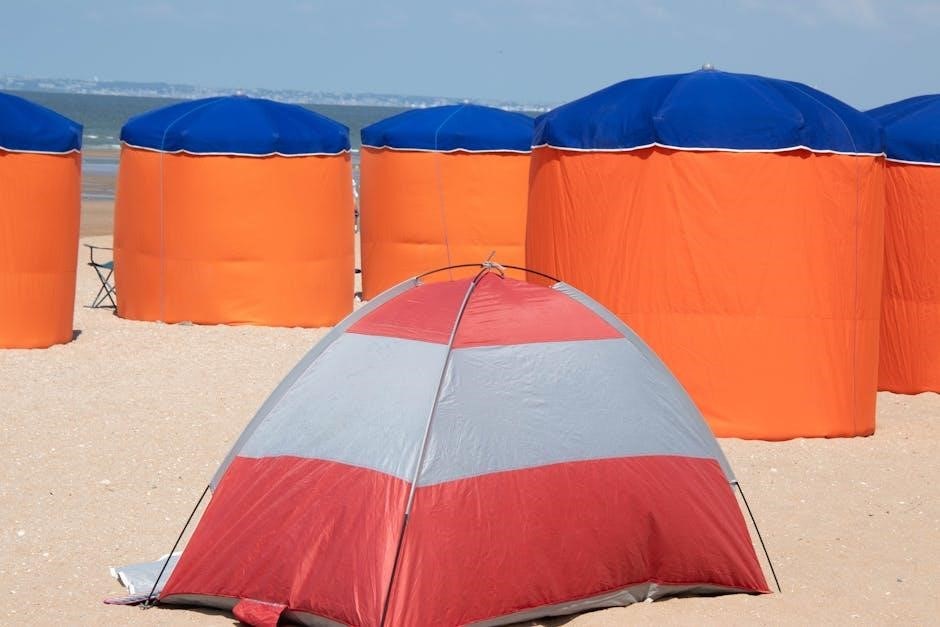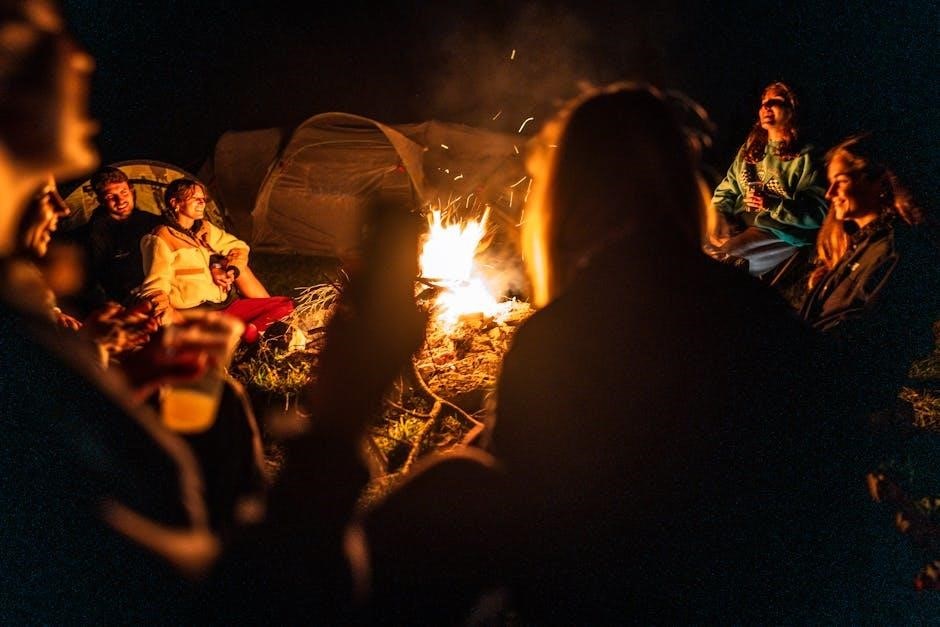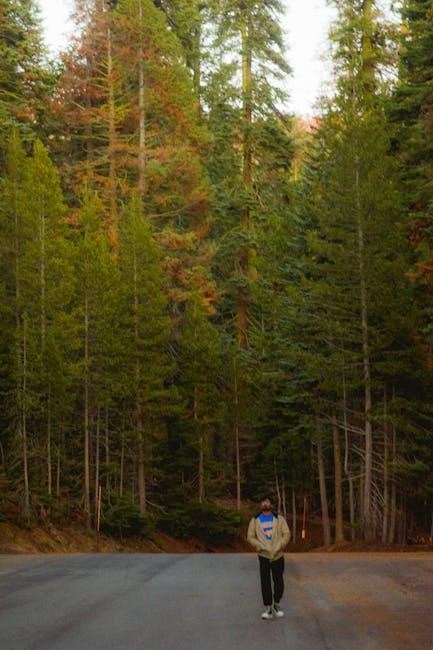Camping knots are essential skills for outdoor enthusiasts‚ offering versatility and reliability in securing gear‚ setting up shelters‚ and ensuring safety. Mastering these knots enhances camping experiences.
Why Camping Knots Are Essential
Camping knots are indispensable for ensuring safety‚ efficiency‚ and reliability in outdoor adventures. They provide secure ways to pitch tents‚ tie gear‚ and create stable structures‚ preventing accidents and equipment damage. Mastery of these knots allows campers to adapt to various situations‚ such as unexpected weather changes or terrain challenges. Properly tied knots also save time and effort‚ enabling campers to focus on enjoying nature. Moreover‚ they are crucial for emergencies‚ like securing ropes for rescues or creating anchor points. Camping knots are not just practical tools but also foundational skills that enhance confidence and self-reliance in the wilderness. Whether setting up camp or navigating trails‚ these knots are vital for a safe and successful outdoor experience.
Overview of Common Camping Knots
Camping knots are categorized into various types‚ each serving specific purposes in outdoor settings. The most frequently used knots include the Square Knot‚ Bowline Knot‚ Sheet Bend‚ and Clove Hitch. These knots are essential for tasks such as securing tents‚ tying gear‚ and creating makeshift pulleys. Additionally‚ the Figure Eight Knot and Timber Hitch are popular for climbing and heavy-duty applications. Knots like the Taut-Line Hitch and Alpine Butterfly Knot offer versatility for adjusting lines and joining ropes. Understanding these knots provides campers with the ability to handle diverse situations‚ from setting up camp to navigating challenging terrain. They are simple yet effective‚ making them indispensable for both beginners and experienced outdoor enthusiasts. Mastering these knots ensures a safer and more efficient camping experience.
Essential Camping Knots
Mastering essential camping knots like the Square Knot‚ Bowline Knot‚ and Sheet Bend is crucial for securing gear‚ setting up shelters‚ and ensuring safety in outdoor adventures.
Square Knot (Reef Knot)
The Square Knot‚ also known as the Reef Knot‚ is a simple yet reliable knot used to securely join two ropes of equal diameter. It is commonly used in camping to tie together tent guy lines‚ secure bundles‚ or even fasten items to a pole. The Square Knot is easy to learn and quick to tie‚ making it a fundamental skill for outdoor enthusiasts. To tie it‚ overlap the two ropes‚ wrap one end over the other‚ then tuck it under and pull tight. This knot is essential for camping tasks‚ providing a strong and dependable connection. Its simplicity and effectiveness make it a must-know for any camper. Regular practice ensures it can be tied quickly and confidently in the field.
Bowline Knot
The Bowline Knot is a timeless and indispensable knot in camping‚ known for creating a secure‚ fixed loop at the end of a rope. It is often referred to as the “king of knots” due to its versatility and reliability. The Bowline is ideal for setting up tents‚ securing gear‚ or creating a pulley system. Its fixed loop makes it perfect for hoisting objects or even rescuing someone‚ as it does not slip under tension. The key to tying a Bowline is forming a “rabbit hole” with the rope‚ then threading the free end through the loop and around the standing part. With practice‚ it becomes second nature. Its resistance to jamming and ease of untangling make it a must-have knot for any camper.
Sheet Bend
The Sheet Bend is a simple yet effective knot used to join two ropes together‚ even if they differ in thickness or material. It is highly reliable and easy to tie‚ making it a favorite among campers for tasks like securing tarps‚ creating longer tow lines‚ or repairing broken ropes. The Sheet Bend works well in wet or slippery conditions and does not require the ropes to be of the same diameter. To tie it‚ form a loop in one rope‚ pass the second rope through it‚ then wrap it around the standing part and tuck it under itself. Pull tight to secure. Its versatility and ease of use make the Sheet Bend an essential knot for camping and outdoor activities‚ ensuring gear remains secure in any situation.
Clove Hitch
The Clove Hitch is a highly reliable and essential knot for camping‚ used to secure ropes to trees‚ poles‚ or other sturdy objects. It is adjustable and easy to release‚ making it ideal for temporary setups like creating a clothesline or anchoring a tent. To tie a Clove Hitch‚ wrap the rope around the post‚ create two loops‚ and pass each loop around the post in opposite directions. Tighten the loops to secure the knot. Its simplicity and versatility make it a must-know for campers‚ as it can be used in various conditions and is easy to adjust even under tension. The Clove Hitch is particularly useful for securing loads that need to be tightened or loosened regularly‚ ensuring a safe and efficient camping experience.

Figure Eight Knot
The Figure Eight Knot‚ also known as the Flemish Knot‚ is a reliable stopper knot commonly used in camping and climbing. It is designed to prevent a rope from running out of a pulley or to add security to a line. This knot is easy to tie and works well with camping ropes due to its simplicity and strength. To create a Figure Eight Knot‚ form a loop in the rope‚ then pass the working end through the loop from the top. Tighten the knot to secure it. It is an excellent choice for creating fixed loops and is often used in rescue operations. The Figure Eight Knot is easy to inspect and untie‚ making it a practical option for campers needing to secure loads or create a quick‚ dependable connection.

Timber Hitch
The Timber Hitch is a robust and versatile knot widely used in camping for securing and transporting heavy objects like logs or equipment. It is easy to tie and adjusts well to uneven surfaces‚ making it ideal for outdoor tasks. To create a Timber Hitch‚ wrap the rope around the object‚ pass the working end under the standing part‚ then loop it over the top and under again‚ finishing with a half hitch. This knot holds tightly under tension‚ ensuring reliability for dragging or lifting. Its simplicity and effectiveness make it a favorite among campers for managing firewood and setting up camp structures. The Timber Hitch is also easy to release‚ even after heavy use‚ making it a practical choice for various camping needs.
Taut-Line Hitch
The Taut-Line Hitch is a highly practical camping knot used to create an adjustable loop‚ ideal for securing tent lines‚ tarps‚ or other gear. It is easy to tie and adjust‚ making it perfect for outdoor situations where tension needs to be modified. To create the Taut-Line Hitch‚ wrap the rope around a post or object‚ pass the working end through a loop‚ then create a series of wraps and pass the end through the final loop. This knot is popular among campers for its simplicity and reliability. It can be tightened or loosened effortlessly‚ even while under load‚ making it essential for setting up camp securely. The Taut-Line Hitch is a must-know for any camper‚ offering versatility and ease of use in various outdoor scenarios.
Alpine Butterfly Knot
The Alpine Butterfly Knot is a reliable and versatile knot commonly used in camping to connect two ropes together‚ especially when they need to be joined in the middle. Known for its strength and security‚ it is often employed in situations requiring a permanent or semi-permanent connection. The Alpine Butterfly Knot is easy to tie and does not jam‚ making it ideal for outdoor activities where quick adjustments may be necessary. It is particularly useful for creating loops in a rope or connecting two ropes of equal diameter. This knot is a favorite among campers and climbers due to its simplicity and effectiveness in various conditions. By mastering the Alpine Butterfly Knot‚ campers can ensure secure and efficient rope management during their adventures.
Choosing the Right Materials for Camping Knots
Selecting the right rope is critical for camping knots‚ ensuring durability and reliability. Opt for weather-resistant‚ high-strength materials like nylon or polyester for secure and long-lasting performance.

Best Ropes for Camping
Camping ropes must be durable‚ weather-resistant‚ and suitable for various tasks. Nylon and polyester are top choices due to their strength and resistance to moisture. For most camping needs‚ a 8-12mm diameter rope is ideal‚ offering a balance between ease of use and reliability. Natural fibers like Manila or Sisal are also options but may degrade faster. Consider ropes with a smooth texture to prevent tangling and ensure easy knot tying. A 20-50 foot length is typically sufficient for setting up shelters‚ securing gear‚ or creating a clothesline. Always store ropes in a dry place to maintain their integrity and avoid exposure to harsh chemicals or extreme heat.
How to Care for Your Rope
Proper rope care ensures longevity and reliability; After use‚ clean ropes with mild soap and water to remove dirt and grime. Avoid using harsh chemicals‚ as they can weaken the material. Dry ropes thoroughly‚ preferably in a shaded‚ well-ventilated area‚ to prevent mold and mildew. Store ropes in a cool‚ dry place away from direct sunlight and extreme heat. Inspect ropes regularly for signs of wear‚ such as fraying or discoloration‚ and replace them if damaged. Avoid exposing ropes to chemicals or abrasive surfaces‚ as this can compromise their strength. Regular maintenance ensures your rope remains durable and dependable for all camping needs.

Learning and Practicing Camping Knots
Mastering camping knots requires consistent practice. Start with basic knots like the square knot and progress to more complex ones like the sheet bend. Dedicate time daily to practice tying and testing knots‚ ensuring they hold securely. Use ropes of varying materials and diameters to build versatility. Regular practice strengthens muscle memory and confidence‚ making knot-tying second nature during camping trips.
Step-by-Step Guide to Practicing Knots

Begin by selecting a quiet‚ distraction-free area to practice. Choose a suitable rope‚ such as nylon or paracord‚ for its durability and ease of handling. Start with simple knots like the square knot‚ focusing on proper looping and tightening techniques. For each knot‚ break it down into individual steps‚ ensuring each loop and twist is precise. Practice tying knots slowly‚ then gradually increase speed as confidence grows. Test the knot’s security by pulling firmly on both ends. Avoid common mistakes‚ such as uneven tension or incorrect wrapping. Use visual aids like diagrams or videos to guide your practice. Repeat each knot multiple times until it becomes second nature. As skills improve‚ progress to more complex knots like the bowline or figure eight. Regular‚ consistent practice is key to mastering camping knots effectively.
Using Visual Aids for Better Understanding
Visual aids are invaluable for mastering camping knots‚ as they provide a clear‚ step-by-step breakdown of each knot’s formation. Diagrams and videos allow learners to observe how ropes interact and how tension affects the knot’s security. Many camping knots PDF guides include detailed illustrations that highlight proper looping‚ wrapping‚ and tightening techniques. These visuals help learners identify common mistakes‚ such as uneven tension or incorrect crossing of ropes. Additionally‚ animated tutorials demonstrate the dynamic process of tying knots‚ making complex patterns easier to follow. By combining written instructions with visual content‚ learners can better grasp the sequence and precision required for each knot. This dual approach enhances retention and confidence‚ ensuring campers can rely on their knots in real-world scenarios.
Importance of Regular Practice
Regular practice is crucial for mastering camping knots‚ as it builds muscle memory and ensures knots are tied consistently and securely. Practicing regularly helps campers develop the necessary speed and confidence to set up camp efficiently‚ even in challenging conditions. Without regular practice‚ knots may be tied incorrectly‚ leading to potential safety risks. Repetition reinforces proper techniques‚ making it easier to recall and execute knots under stress. Over time‚ consistent practice enhances problem-solving skills‚ allowing campers to adapt knots to different scenarios. By dedicating time to practice‚ campers can ensure their knots are reliable and trustworthy‚ which is essential for a safe and enjoyable outdoor experience. Regular practice transforms knot-tying into a second nature‚ providing peace of mind in the wilderness.

Tips for Mastering Camping Knots
Consistent practice‚ patience‚ and understanding each knot’s purpose are key to mastery. Use high-quality ropes and start with simple knots‚ gradually progressing to more complex ones.

Best Practices for Tying Knots
When tying camping knots‚ always start with clean‚ dry ropes to ensure grip and reliability. Maintain consistent tension while forming loops and wraps to prevent slack. Practice knot-tying in a controlled environment before relying on them in the field. Use visual aids like diagrams or videos to guide your technique. Double-check knots by tugging gently on both ends to confirm they hold securely. Avoid over-tightening‚ as this can damage the rope or make the knot difficult to untie. Keep your knots organized to prevent tangles and ensure quick access. Regular practice strengthens muscle memory‚ making knot-tying faster and more intuitive. Start with simple knots like the square knot and progress to more complex ones like the bowline. Patience and repetition are key to mastering reliable camping knots.

Common Mistakes to Avoid
One of the most frequent errors when tying camping knots is applying uneven tension‚ which can lead to a weak or unstable knot. Over-twisting or looping the rope incorrectly can also compromise the knot’s integrity. Many campers fail to double-check their knots‚ leading to unexpected failures in critical situations. Using the wrong type of knot for the task is another common mistake‚ as certain knots are better suited for specific applications. Additionally‚ neglecting to maintain rope condition by ignoring frays or dirt can undermine knot reliability. Avoid rushing the process‚ as patience is key to securing a strong and dependable knot. Lastly‚ never rely on a knot without testing it first‚ even if it appears correct.
Camping knots are indispensable for a safe and efficient outdoor experience. Mastering these essential skills ensures reliability in various camping scenarios‚ making every adventure more enjoyable and secure.
Final Thoughts on Camping Knots
Mastery of camping knots is a valuable skill for outdoor enthusiasts‚ enhancing safety and efficiency in setting up shelters‚ securing gear‚ and navigating challenges. From the square knot to the bowline‚ these knots are timeless tools that empower campers to handle diverse situations confidently. Regular practice and understanding the proper techniques ensure reliability‚ while quality materials further enhance performance. Whether for recreational camping or more demanding expeditions‚ camping knots are indispensable. They not only simplify tasks but also contribute to a more enjoyable and secure outdoor experience. Embracing these skills fosters self-reliance and preparedness‚ making every camping adventure safer and more rewarding.
Encouragement to Keep Learning
Learning camping knots is a lifelong skill that enhances outdoor adventures and fosters self-reliance. While it may seem challenging at first‚ consistent practice and patience lead to mastery. Exploring resources like camping knots PDF guides provides visual aids and step-by-step instructions‚ making the process easier. Joining online communities or forums connects you with experienced enthusiasts who share tips and inspire improvement. Remember‚ every knot learned is a step toward greater confidence and safety in the wilderness. Embrace the journey‚ stay curious‚ and enjoy the satisfaction of mastering these essential outdoor skills. The more you learn‚ the more prepared and capable you’ll feel on your next camping trip.

Additional Resources
Discover comprehensive camping knots PDF guides online‚ offering detailed instructions and visuals. Explore platforms like REI or expert forums for downloadable resources and expert tips.
Recommended Camping Knots PDF Guides
For campers seeking detailed instructions‚ numerous high-quality camping knots PDF guides are available online. Platforms like REI and expert outdoor forums offer free downloadable resources.
These guides typically include step-by-step tutorials‚ clear visuals‚ and practical applications for various camping scenarios. They cover essential knots like the Square Knot‚ Bowline‚ and Sheet Bend.
Many PDFs are designed for beginners‚ breaking down complex knots into easy-to-follow instructions. Some guides also focus on specific camping needs‚ such as setting up shelters or securing gear.
Additionally‚ websites like ExpertOutdoors and KnotsGuide provide comprehensive PDF manuals. These resources are perfect for printing and carrying on camping trips.
They ensure campers are always prepared with the right knots for any situation.
Online Communities for Knot Enthusiasts
Online communities are invaluable for campers and knot enthusiasts‚ offering a wealth of knowledge and shared experiences. Forums like REI Co-op and ExpertOutdoors provide detailed discussions and tutorials on camping knots.
Social media groups‚ such as those on Facebook and Reddit‚ connect enthusiasts worldwide‚ sharing tips and troubleshooting common challenges.
Websites like KnotsGuide and Animated Knots feature interactive tutorials and step-by-step guides for mastering essential camping knots.
These platforms also offer downloadable PDF resources‚ making it easy to practice and reference knots on the go.
By joining these communities‚ campers can enhance their skills‚ learn new techniques‚ and gain confidence in their ability to secure gear and stay safe outdoors.